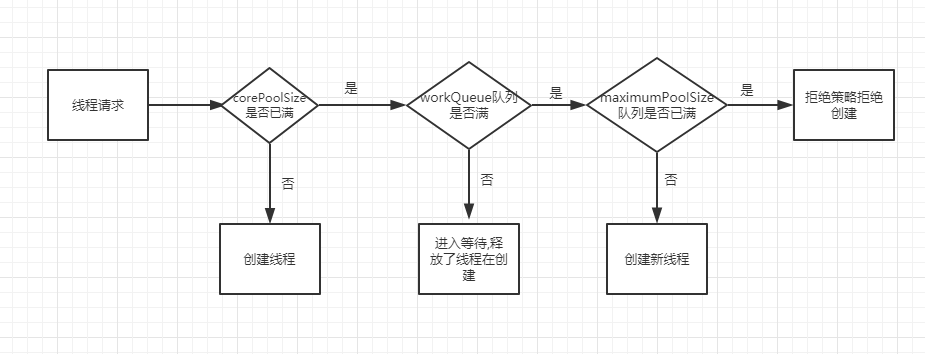java基础-多线程二
java基础-多线程二继承thread和实现Runnable的多线程每次都需要经历创建和销毁的过程,频繁的创建和销毁大大影响效率,线程池的诞生就可以很好的解决这一个问题,线程池可以充分的利用线程进行任务调度,重复利用 1. 线程池Executor与ExecutorsExecutor为concurrent包下的线程顶级接口,提供了一个execute方法,参数为Runnable的实例 void execute(Runnable command);
Executors负责创建不同功能的线程池,线程工厂的角色,都是返回ExecutorService 2. 线程池的日常使用2.1 newFixedThreadPool:创建指定大小的线程池,当有新任务提交时,如果线程池存在空闲则立即执行,繁殖则会加入阻塞队列中进行等待,等待唤醒并执行;适用于多任务异步执行 // 创建一个10个活跃线程池
ExecutorService service = Executors.newFixedThreadPool(10);
public static ExecutorService newFixedThreadPool(int nThreads) {
return new ThreadPoolExecutor(nThreads,nThreads,0L,TimeUnit.MILLISECONDS,new LinkedBlockingQueue<Runnable>());
}
2.2 newSingleThreadExecutor: 只有一个线程的线程池,在发生异常的时候会创建一个新的线程池继续执行, 返回FinalizableDelegatedExecutorService实例;核心线程数为1,最大线程数也为1,空闲线程等待时间为0,LinkedBlockingQueue无界等待队列(链表结构) 适用于单个任务执行 ExecutorService service = Executors.newSingleThreadExecutor();
public static ExecutorService newSingleThreadExecutor() {
return new FinalizableDelegatedExecutorService
(new ThreadPoolExecutor(1,1,new LinkedBlockingQueue<Runnable>()));
}
public class TestSingleThreadExecutor {
static class Test implements Runnable {
private Integer num;
private String threadType;
Test(Integer param,String threadType) {
this.num = param;
this.threadType = threadType;
}
@Override
public void run() {
System.out.println(threadType + "num=" + num + "==>" + Thread.currentThread().getName() + "线程计算=" + num / (num - 2));
}
}
public static void main(String args[]) {
ExecutorService service = Executors.newSingleThreadExecutor();
ExecutorService service1 = Executors.newFixedThreadPool(4);
for (int i = 10; i >= 1; i--) {
service.execute(new Test(i,"newSingleThreadExecutor"));
// service1.execute(new Test(i,"newFixedThreadPool"));
}
}
}
// 执行结果:
Exception in thread "pool-1-thread-1" java.lang.ArithmeticException: / by zero
at com.hervey.thread.TestSingleThreadExecutor$Test.run(TestSingleThreadExecutor.java:28)
at java.util.concurrent.ThreadPoolExecutor.runWorker(ThreadPoolExecutor.java:1149)
at java.util.concurrent.ThreadPoolExecutor$Worker.run(ThreadPoolExecutor.java:624)
at java.lang.Thread.run(Thread.java:748)
newSingleThreadExecutornum=10==>pool-1-thread-1线程计算=1
newSingleThreadExecutornum=9==>pool-1-thread-1线程计算=1
newSingleThreadExecutornum=8==>pool-1-thread-1线程计算=1
newSingleThreadExecutornum=7==>pool-1-thread-1线程计算=1
newSingleThreadExecutornum=6==>pool-1-thread-1线程计算=1
newSingleThreadExecutornum=5==>pool-1-thread-1线程计算=1
newSingleThreadExecutornum=4==>pool-1-thread-1线程计算=2
newSingleThreadExecutornum=3==>pool-1-thread-1线程计算=3
newSingleThreadExecutornum=1==>pool-1-thread-2线程计算=-1
2.3?newCachedThreadPool:? 当线程池中无可用线程时,创建和任务等同数量的线程,后续有新任务进来时,如果线程池中之前执行的线程还未被回收,则不会创建新线程直接复用之前的线程(新任务的数量<=线程池中已完成单位被回收的线程),这就是cache线程池;适用于耗时较短的任务 // SynchronousQueue同步队列用来存储等待的队列
public static ExecutorService newCachedThreadPool() {
return new ThreadPoolExecutor(0,Integer.MAX_VALUE,60L,TimeUnit.SECONDS,new SynchronousQueue<Runnable>());
}
public class TestCacheThreadPool {
static class Test implements Runnable {
@Override
public void run() {
System.out.println(Thread.currentThread().getName() + "正在执行");
}
}
public static void main(String[] args) throws InterruptedException {
ExecutorService service = Executors.newCachedThreadPool();
for (int i = 0; i< 5; i++) {
service.execute(new Test());
}
Thread.sleep(2000);
System.out.println("沉睡2秒");
for (int i = 0; i < 3; i++) {
service.execute(new Test());
}
}
}
// 执行结果:
pool-1-thread-3正在执行
pool-1-thread-2正在执行
pool-1-thread-1正在执行
pool-1-thread-5正在执行
pool-1-thread-4正在执行
沉睡2秒
pool-1-thread-4正在执行
pool-1-thread-5正在执行
pool-1-thread-1正在执行
// 如果线程池中的线程可用数量小于新任务的数量,则会一直复用线程池中可用的线程,没有可用的时候则会创建新的线程
public static void main(String[] args) throws InterruptedException {
ExecutorService service = Executors.newCachedThreadPool();
for (int i = 0; i< 5; i++) {
service.execute(new Test());
}
Thread.sleep(2000);
System.out.println("沉睡2秒");
for (int i = 0; i < 10; i++) {
service.execute(new Test());
}
}
// 执行结果:
pool-1-thread-1正在执行
pool-1-thread-2正在执行
pool-1-thread-3正在执行
pool-1-thread-2正在执行
pool-1-thread-4正在执行
沉睡2秒
pool-1-thread-1正在执行
pool-1-thread-2正在执行
pool-1-thread-3正在执行
pool-1-thread-4正在执行
pool-1-thread-2正在执行
pool-1-thread-1正在执行
pool-1-thread-3正在执行
pool-1-thread-4正在执行
pool-1-thread-5正在执行
pool-1-thread-6正在执行
2.4?newScheduledThreadPool: 可以设置计划时间执行的线程池,类似于quartz-scheduler定时任务,可以设置延时执行,每隔多久执行一次 // 使用newScheduledThreadPool
ScheduledExecutorService service = Executors.newScheduledThreadPool(3);
// 源码:
public static ScheduledExecutorService newScheduledThreadPool(int corePoolSize) {
return new ScheduledThreadPoolExecutor(corePoolSize);
}
//DelayedWorkQueue 延迟队列
public ScheduledThreadPoolExecutor(int corePoolSize) {
super(corePoolSize,NANOSECONDS,new DelayedWorkQueue());
}
ScheduledExecutorService定时方法// 延迟执行 Runnable实例,delay延时时长,TimeUnit时间单位 public ScheduledFuture<?> schedule(Runnable command,long delay,TimeUnit unit); // Callable实例 public <V> ScheduledFuture<V> schedule(Callable<V> callable,TimeUnit unit); // Runnable实例,initialDelay:初始化延时时间,period:每隔多长时间执行,TimeUnit:时间单位 public ScheduledFuture<?> scheduleAtFixedRate(Runnable command,long initialDelay,long period,TimeUnit unit); // Runnable实例,initialDelay:首次延迟时间,delay:后续延迟时间执行,TimeUnit:时间单位 public ScheduledFuture<?> scheduleWithFixedDelay(Runnable command,TimeUnit unit); 上述都是日常比较常见的各种线程池的用法及作用,我们需要根据我们的使用场景来灵活调用,我们可以查看下源代码,线程池是怎么创建的及各参数的具体意义 public ThreadPoolExecutor(int corePoolSize,int maximumPoolSize,long keepAliveTime,TimeUnit unit,BlockingQueue<Runnable> workQueue,ThreadFactory threadFactory,RejectedExecutionHandler handler) 线程池的各参数的概念及作用
3. 线程池流程图<center></center> (编辑:李大同) 【声明】本站内容均来自网络,其相关言论仅代表作者个人观点,不代表本站立场。若无意侵犯到您的权利,请及时与联系站长删除相关内容! |
- mouseevent – 从一个节点获取MOUSE_PRESSED事件后,无法从任
- 如何在java方法中传递数组作为参数?
- java – 将.war文件部署到tomcat 8在IDE中正常工作但是当我
- Java代码复用的三种常用方式:继承、组合和代理
- java – 如何在spring-security中的另一个过滤器之前添加过
- java文件读写工具类分享
- try-catch块不能抑制java.lang.NullPointerException
- Java单例模式下的MongoDB数据库操作工具类
- Java concurrency集合之CopyOnWriteArraySet_动力节点Java学
- Spring boot外部配置(配置中心化)详解

